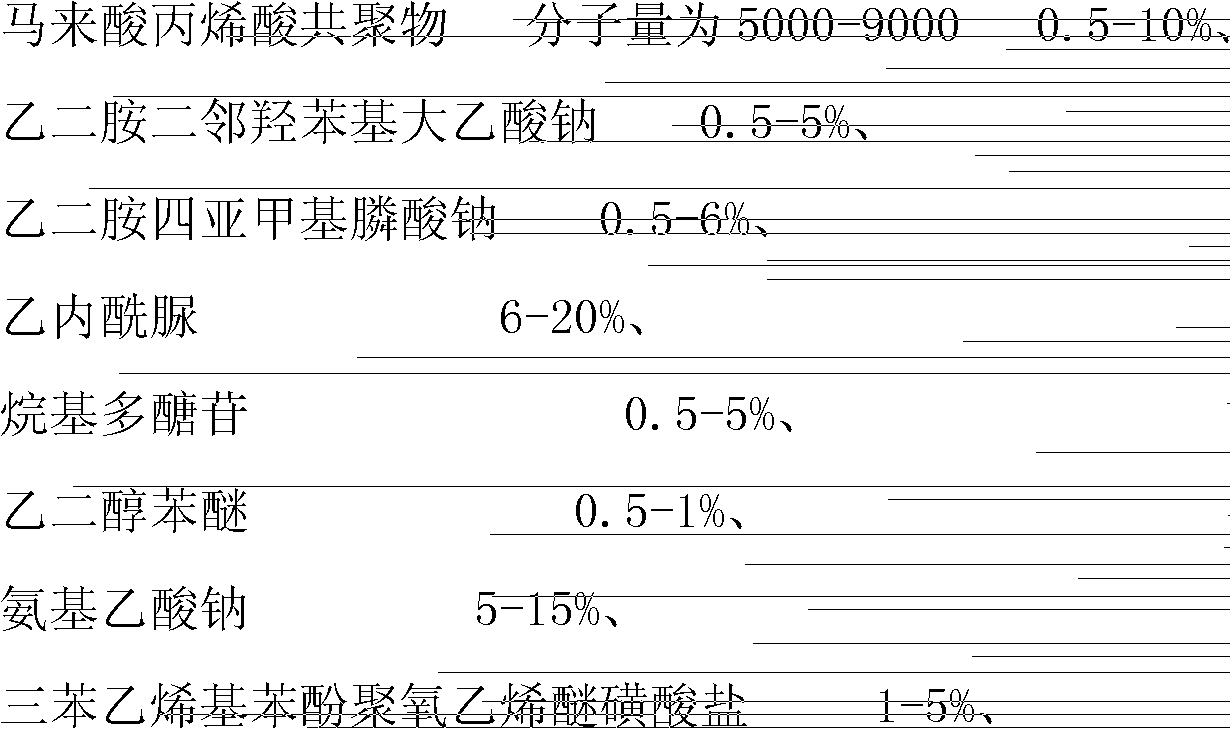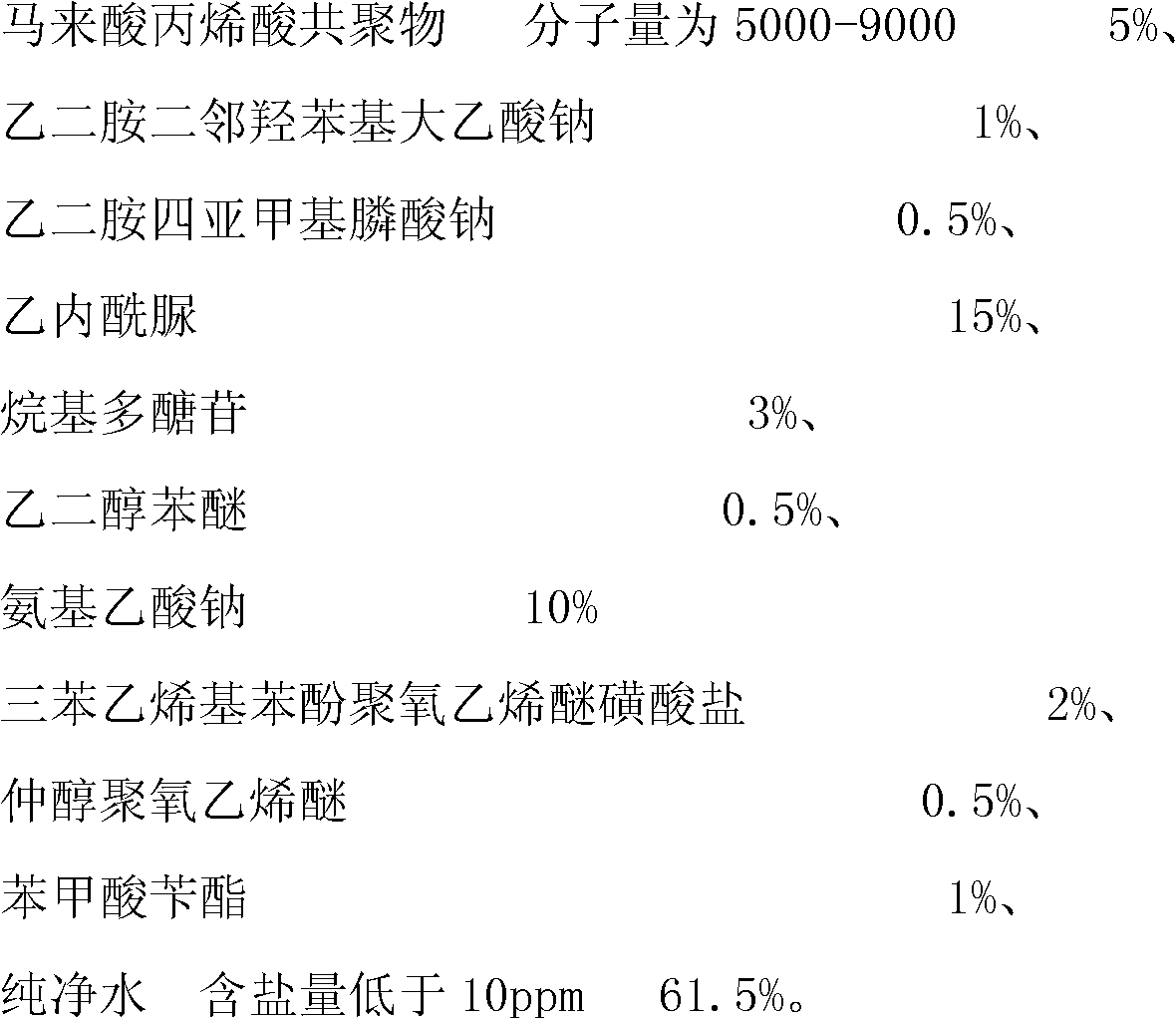Short-process low-temperature dyeing aid and preparation method thereof
A low-temperature dyeing and short-process technology, which is applied in the fields of dyeing, textiles and papermaking, can solve the problems of long process and achieve the effects of improving production efficiency, eliminating reduction cleaning process, and saving steam
- Summary
- Abstract
- Description
- Claims
- Application Information
AI Technical Summary
Problems solved by technology
Method used
Image
Examples
Embodiment 1
[0014] The components of a short-process low-temperature dyeing auxiliary agent of the present invention are as follows in weight percentage:
[0015]
[0016] The preparation method of this dyeing auxiliary: first add the pure water of the entire formula into the emulsification disperser equipped with a stainless steel stirrer, and then start the equipment to adjust the components according to the maleic acid acrylic copolymer and ethylenediamine di-hydroxyl Sodium phenyl large acetate, sodium ethylene diamine tetramethylene phosphonate, hydantoin, alkyl polyglycoside, glycol phenyl ether, sodium aminoacetate, tristyryl phenol polyoxyethylene ether sulfonate, The secondary alcohol polyoxyethylene ether, benzyl benzoate, and purified water are added sequentially. After all the components are added, the emulsification and dispersion are continued for 0.5-2 hours, and the stirring is stopped after the solution becomes transparent and light brown, and the processing is completed.
Embodiment 2
[0018] The components of a short-process low-temperature dyeing auxiliary agent of the present invention are as follows in weight percentage:
[0019]
[0020] The preparation method of this dyeing auxiliary is the same as in Example 1.
[0021] Taking polyester knitted fabric as an example, the polyester knitted grey fabric is dyed directly into the vat without pre-treatment and degreasing. First, add 1.5-3g / l of the short-flow low-temperature dyeing auxiliary in Example 1 or Example 2 of the present invention, and then Add disperse dye to control the heating rate at 0.6-1°C / min from 60°C, directly increase the temperature to 120-125°C and keep it for 20-50 minutes, and then reduce the temperature to 75°C at a cooling rate of 1-2°C / min Drain the liquid and wash it with water. After dyeing, the medium and light colors need to be washed 1-2 times, and the dark colors need to be washed with hot water above 80℃, and then washed with cold water to get out of the tank, that is, the same...
Embodiment 3
[0025] The components of a short-process low-temperature dyeing auxiliary agent of the present invention are as follows in weight percentage:
[0026]
[0027] The preparation method of this dyeing auxiliary: first add the pure water of the entire formula into the emulsification disperser equipped with a stainless steel stirrer, and then start the equipment to adjust the components according to the maleic acid acrylic copolymer and ethylenediamine di-hydroxyl Sodium phenyl large acetate, sodium ethylene diamine tetramethylene phosphonate, hydantoin, alkyl polyglycoside, glycol phenyl ether, sodium aminoacetate, tristyryl phenol polyoxyethylene ether sulfonate, The benzyl benzoate and purified water components are added sequentially, and the emulsification and dispersion are continued for 0.5-2 hours after all the components are added, and the stirring is stopped after the solution becomes transparent and light brown, and the processing is completed.
[0028] Take the polyester / visc...
PUM
 Login to View More
Login to View More Abstract
Description
Claims
Application Information
 Login to View More
Login to View More - R&D
- Intellectual Property
- Life Sciences
- Materials
- Tech Scout
- Unparalleled Data Quality
- Higher Quality Content
- 60% Fewer Hallucinations
Browse by: Latest US Patents, China's latest patents, Technical Efficacy Thesaurus, Application Domain, Technology Topic, Popular Technical Reports.
© 2025 PatSnap. All rights reserved.Legal|Privacy policy|Modern Slavery Act Transparency Statement|Sitemap|About US| Contact US: help@patsnap.com



